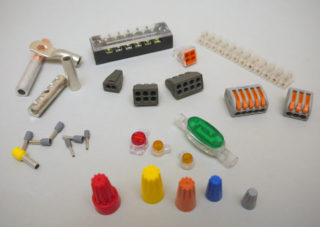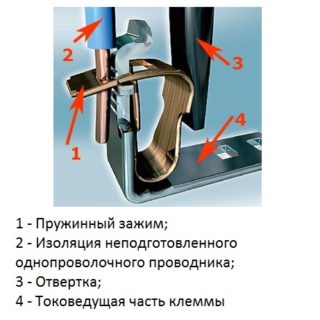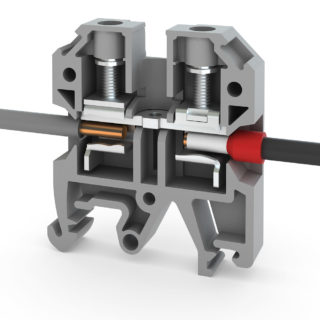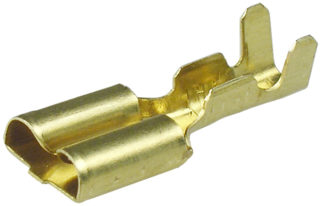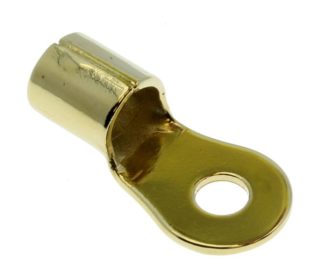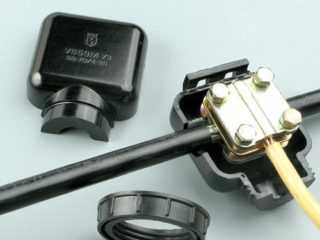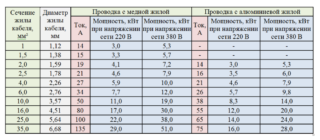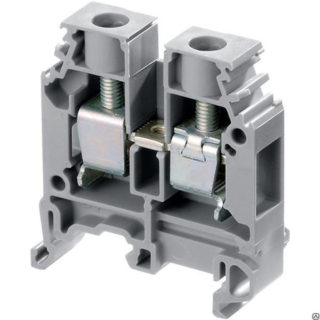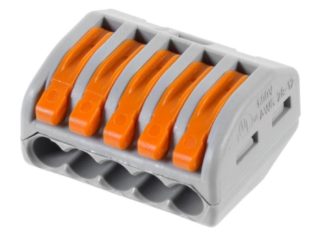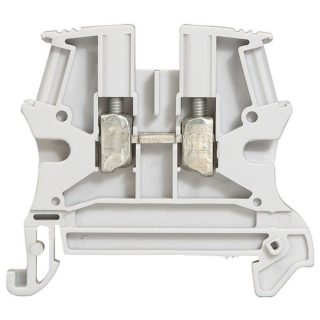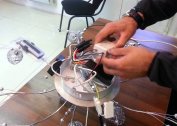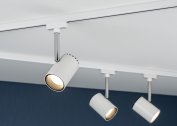The method of connecting the cables of the electrical wiring depends on the requirements of operation, ensuring the safety of communications. The main methods are welding, mechanical twisting, installation of terminal blocks. Using terminal blocks is a simple and reliable way to connect wires of any type. Clips for wires accelerate installation, allow you to update the connection. Their use ensures the reliability of electrical installation, performed independently, without the involvement of an electrician.
Basic requirements for terminal blocks for connecting wires
Wiring accessories are manufactured according to special standards and norms. There are several requirements for terminal connectors:
- Resistance to heat and burning. For the body materials are used, self-extinguishing when ignited. Polyamide is recommended; it is used by WAGO and Legrand.
- Reliable and quick contact locking. It is recommended that you leave a sufficient cable length for communication so that there is no tension.
- The properties of the clamps must not be changed during the period of operation.
- The size of the contact plates should prevent contact between the cores of different materials. To ensure low resistance, copper and brass parts are coated with a special paste.
- Information on the main characteristics of the device is applied to the body of the product.
One of the essential requirements is protection against accidental access.
Advantages and disadvantages of switching terminals
To connect the power cable on the street or in the house, the simplest option is to use connection terminals for occasions. The main advantages of the method:
- constructive variety of connectors;
- the possibility of dismantling and repair;
- simplicity, speed and availability of the installation;
- electrical safety, a dielectric housing protects against electric shock;
- resistance to mechanical stress and vibration;
- the possibility of switching metal conductors of different sections and material.
Disadvantages:
- the allocation of additional space in the shields and junction boxes;
- high cost for large-scale work.
The electric clamps are durable and reliable, for their installation it is enough to have a screwdriver.
How to choose the right terminals for wires
Before purchasing the connection terminals for wires, you need to study the power cable. The following information is required:
- section;
- number of cores;
- conductor material.
An important criterion is the rated current. This characteristic is specified by the manufacturer. If it is insufficient, the connector will begin to heat up and melt. The material of the case matters. For household appliances, sockets and switches, products made of polypropylene and polyamide are suitable. Ceramic devices are recommended for power buses. The last criterion is the size of the terminal. It must be compact to fit in a confined space.
Types of electrical connection blocks
Devices for switching wiring are selected depending on the destination. Among the many models, the best option is selected. There are several ways to fix the conductors in the pads.
Spring loaded
A common version of spring type products is self-locking terminals. They are disposable and reusable. In the first case, after fixing, the wire cannot be pulled out without significant damage. In reusable models, it is released using a lever. Advantages of the method:
- installation does not require experience and tools;
- the stripped end of the wire is fixed by the spring after being inserted into the groove;
- The connection is reliable and durable.
Spring-loaded contact plates made of copper fix multicore wires without damage. The quality of the wiring connection does not depend on the professionalism of the master. Even a beginner can easily cope with the self-clamping mechanism. The leader in the production of devices with automatic contact clamps is the German company WAGO. The disadvantage is the high cost of products.
Screw
Screw connectors hold the wire on the pad using screw pressure. The metal clip is placed in a plastic case. Advantages of switches:
- the ability to use repeatedly;
- the block consists of many parts;
- Installation is carried out with one screwdriver.
Disadvantages of screw pads:
- sensitivity to vibration;
- not recommended for aluminum cable;
- regular maintenance is required (tightening screws).
Screw type terminal blocks are not suitable for stranded wires. It is recommended for single core copper cable. When tightening the screws, a certain effort is required in order to perform the connection correctly, experience is required. Well-known manufacturers of screw switches are Legrand and Wiedmuller.
Knife type
Knife-type switches are installed in the grounding system circuits. They are recommended in areas where the wire is not cut according to safety requirements. Their feature is the lack of the need to remove insulation from the contact. The wire is inserted into the terminal strip, where a special knife cuts through the braid and securely fixes the core. This type of connector has its advantages:
- installation is accelerated;
- compact dimensions;
- No professional installation skills required.
Knife terminal blocks are not used for power circuits, most often they are used to connect audio equipment.
Terminals on Plastic Pads
Pads are used to connect two wires. They come with different diameters of the hole for the conductive core. Devices allow you to connect cables to one or more cores, conductors of various sections. The design of the blocks eliminates oxidation processes when switching wires made of copper and aluminum. Some models are filled with anti-corrosion paste. A special recess in the plastic prevents pressure on the core when tightening the screw. The transparent case of the products makes it possible to assess the condition of the contacts.
Wire connection terminals
Common crimp terminal designs for wiring include:
- Ring - round clamps are characterized by the most reliable contact due to the large area of contact. They are recommended for low current and power networks. Products are a metal ring and a shank. The terminals are made of copper or aluminum. Product sizes are presented in the range of 3-27 mm.
- Pin - detachable parts, consisting of two parts - plugs and sockets. These are insulated devices whose color indicates the power of the terminal block. Connection details are marked with “A” and “B”.
- Fork - Fork type terminals are designed for screw mounting. They are used in secondary and power circuits. The material for the products is aluminum, brass and various copper alloys. Structurally, the clamps represent a fork with two teeth, with or without insulation. Suitable for wires not exceeding 6 mm in diameter.
- Knife - a common option for stranded wires of a small cross section.Terminals are used for household appliances - irons, refrigerators. The design of the products is a pair of "father and mother." The coloring of the insulation depends on the power, the maximum parameter is 5 kW.
The use of terminals is the simplest and most economical option for switching electrical wires.
Walnut branch clamps
The clamp for branching the main branch without separation consists of a plastic case and metal plates with bolts. On the dies there are grooves for contacts. When choosing a model, take into account the cross section of the main wire and branches. Such a connector can be used for switching aluminum and copper wires. Between the two dies is a dividing plate made of brass.
For junction boxes
The wires of all connected devices are inserted into the junction box. Terminal blocks for junction boxes are designed for branching electrical wiring. Their case is made of polycarbonate, and the contact pad is made of copper. Fixation is carried out by a spring mechanism.
With fuse
The devices have an additional element in the design - a fuse. The terminals are oversized. They are installed in AC and DC networks. Scope - switching electrical appliances without built-in fuses and installation in a panel on a DIN rail.
Which terminals for switching wires is better to use
To find suitable terminals for connecting the wire, simple rules will help:
- Focus on the technical parameters of the terminal blocks. The main characteristics include rated current and conductor diameter. Marking is applied to the product body.
- If necessary, the connection of conductors of different metals choose a block with a special filler. The paste prevents oxidation processes when switching aluminum and copper.
- Select products from material suitable for the operating conditions.
When choosing connectors, the quality of materials and assembly plays a role, it is better to give preference to well-known manufacturers. A low-grade terminal block for wires from China can cause a short circuit or fire.
Overview of wiring device manufacturers
Fire safety depends on the quality of products that you have to use when installing wiring. Products of unknown companies can be made from cheap substitutes for brass and high-quality plastic. Well-known electrical manufacturers offer reliable terminal connections.
ABB
ABB Group of Companies is a leader in the production of high-class electrical equipment. Its range allows you to choose products for any type of work. The brand offers terminal blocks for wires of the main connection types: spring, screw, plug-in systems with insulation cutting, etc. Product advantages:
- great quality;
- variety of models;
- innovative developments;
- reliability.
The manufacturer's unique products are Essailec test blocks and ADO System terminal blocks.
Wago
The products of the German company WAGO have gained popularity due to their reliability and ease of use. The most popular were spring self-clamping terminal blocks. With their help, soft multicore and single-core cables of various diameters are fixed without damage. Product Advantages:
- resistance to vibration;
- contact connection speed;
- constant pressure eliminates the deformation of the core;
- access of measuring instruments during repair is possible.
The reliability of the design is ensured by a steel spring and a polyamide housing. The company offers clamps for detachable and one-piece communication. They are suitable for wires up to 4 square meters. mm
Legrand
The Legrand brand has earned respect and recognition in the market for electrical infrastructure products. The company offers terminal blocks with screw and spring clamps. Product Advantages:
- resistance to pulling out the wire;
- mechanical strength;
- simple installation;
- variety of sizes.
The contact pads of the devices are made of nickel-plated brass that improves current conductivity.
Terminal Connection Technology
The functioning of the electrical network and devices depends on the correct switching of the wires. The nuances of the connection depend on the type of terminal block. When working with WAGO 2273 series self-clamping blocks, it is enough to strip the wire from insulation in a 10 mm section. Work is carried out carefully so as not to damage the conductive core. The end of the contact is inserted with force into the terminal hole.
The universal connectors of the 222 and 221 series have levers for securing the conductor. They are previously lifted up. After inserting the stripped core, the part is lowered. Reusable devices, easily disconnected. Compact cable clamp terminals are used in junction boxes. They are placed at a distance from each other to reduce the likelihood of heating and short circuiting.
Blocks of the 224 series are used in the installation of lighting fixtures. The terminal blocks for connecting wires have special holes for single-core and multi-core contacts.
WAGO 773 connectors are disposable. The tip inserts into the hole without insulation and is fixed with an internal clamp. If necessary, they take it out, making scrolling movements. Checking the reliability of the fixation of the wire in the connecting device is performed with a slight twitch.
